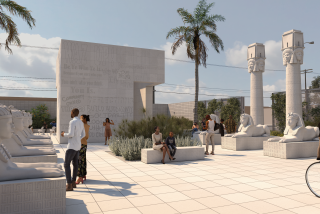9/11 Memorial Finalists Unveiled
- Share via
WASHINGTON — Dewy glass walls and the infinite sky could be components of a memorial to victims of the Sept. 11 attack on the Pentagon, according to a panel that unveiled six finalists Thursday in the competition to design the monument.
Inspired by the ripple effect of the tragedy and the location of the site -- across the Potomac River in Arlington, Va., under the flight path of American Airlines Flight 77 -- the finalists used metaphors and aesthetics that evoked elements of the haunting Vietnam Veterans memorial.
“We began to realize what a powerful effect or influence the Vietnam memorial had on our thinking,” said jury member Terence Riley, chief curator of the department of architecture and design at New York City’s Museum of Modern Art. “It has changed everyone’s thinking about what a memorial is.”
The Vietnam Veterans Memorial wall, designed by Maya Lin, is a V-shaped wall engraved with the names of the 58,209 Americans who died during the war.
It is designed to resemble healing, outstretched arms, and Lin hoped that visitors would find a place of quiet reflection. Mourners are frequently seen making rubbings of the inscribed names.
Similarly, the final six Pentagon memorial designs, chosen from 1,126 entries, sought interaction between visitors and the monument. Like the Vietnam Veterans Memorial, the Pentagon memorial would be inscribed with the names of all 184 victims.
One design, by Jean Koeppel of Brooklyn, N.Y., features a pool from which water would condense onto 184 glass monoliths perched over it, giving visitors ephemeral spots to rub messages into the dew.
Another, by Mason Wickham, also of Brooklyn, is a communal table surrounded by a walled garden. The table is lined with 184 benches on which visitors could sit.
In a third design, the visitors themselves would be the monument. Designed by Michael Meredith of Clifton Park, N.Y., the memorial would be a pedestal angled toward the Pentagon, set amid cherry trees and benches. The design “leaves the memorial unfinished, only to be completed by those who visit and stand upon it,” Meredith wrote.
Still another features 184 benches perched over lighted reflecting pools, designed by Julie Beckman of New York City. A fifth, designed by Shane Williamson of Toronto, proposes a structure of alternating blocks representing the lives lost and voids representing the world’s loss.
The sixth entry, designed by Jacky Bowring of Canterbury, New Zealand, proposes 184 concrete wells of “calm water” with mirrors at their bases and etchings chosen by the victims’ families inscribed on each top.
Not included in any of the finalist designs is a direct view of the Pentagon’s rebuilt west-facing wall. The families of the victims, Riley said, felt that the sight would be too disturbing. Instead, the wall around Wickham’s communal table would reflect the image of that facade, which will stand only 165 feet from the memorial.
The sky also plays a role in the designs. The condensation on Koeppel’s monoliths would fade the higher the glass stands over the water, “like veils that optically disappear toward the sky.”
And backdrop of Bowring’s “calm water” etchings would be the heavens, reflected in the mirrors at the base.
Because the attack was so personal and the loss indescribable, Riley said, the jury picked designs that left interpretation up to visitors. “They can kind of find in it that which they are hoping to find,” he said.
The finalists will each be given $20,000 to further develop their plans, and the jury aims to pick a winner around the first of the year, said project manager Carol Anderson-Austra of the U.S. Army Corps of Engineers.
More to Read
The biggest entertainment stories
Get our big stories about Hollywood, film, television, music, arts, culture and more right in your inbox as soon as they publish.
You may occasionally receive promotional content from the Los Angeles Times.










